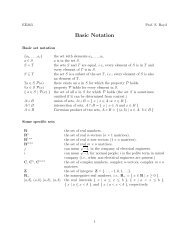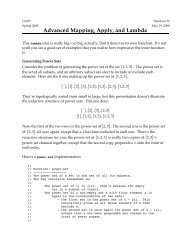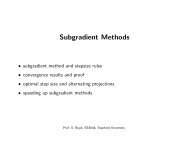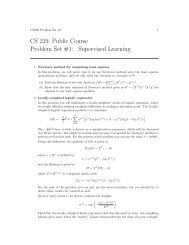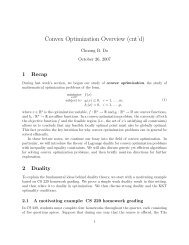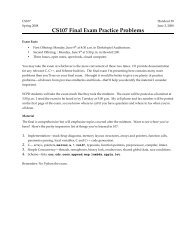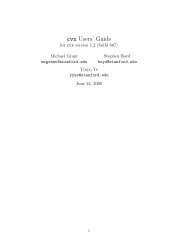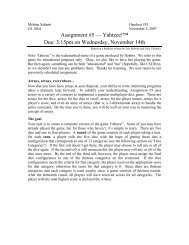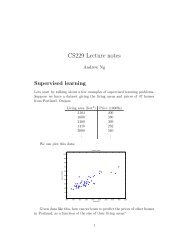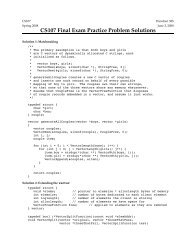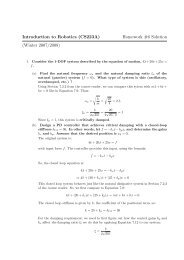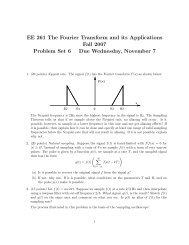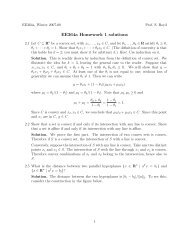CS 229, Public Course Problem Set #2: Kernels, SVMs, and Theory
CS 229, Public Course Problem Set #2: Kernels, SVMs, and Theory
CS 229, Public Course Problem Set #2: Kernels, SVMs, and Theory
Create successful ePaper yourself
Turn your PDF publications into a flip-book with our unique Google optimized e-Paper software.
<strong>CS</strong><strong>229</strong> <strong>Problem</strong> <strong>Set</strong> <strong>#2</strong> 1<strong>CS</strong> <strong>229</strong>, <strong>Public</strong> <strong>Course</strong><strong>Problem</strong> <strong>Set</strong> <strong>#2</strong>: <strong>Kernels</strong>, <strong>SVMs</strong>, <strong>and</strong> <strong>Theory</strong>1. Kernel ridge regressionIn contrast to ordinary least squares which has a cost functionJ(θ) = 1 m∑(θ T x (i) − y (i) ) 2 ,2i=1we can also add a term that penalizes large weights in θ. In ridge regression, our leastsquares cost is regularized by adding a term λ‖θ‖ 2 , where λ > 0 is a fixed (known) constant(regularization will be discussed at greater length in an upcoming course lecutre). The ridgeregression cost function is thenJ(θ) = 1 m∑(θ T x (i) − y (i) ) 2 + λ 22 ‖θ‖2 .i=1(a) Use the vector notation described in class to find a closed-form expreesion for thevalue of θ which minimizes the ridge regression cost function.(b) Suppose that we want to use kernels to implicitly represent our feature vectors in ahigh-dimensional (possibly infinite dimensional) space. Using a feature mapping φ,the ridge regression cost function becomesJ(θ) = 1 m∑(θ T φ(x (i) ) − y (i) ) 2 + λ 22 ‖θ‖2 .i=1Making a prediction on a new input x new would now be done by computing θ T φ(x new ).Show how we can use the “kernel trick” to obtain a closed form for the predictionon the new input without ever explicitly computing φ(x new ). You may assume thatthe parameter vector θ can be expressed as a linear combination of the input featurevectors; i.e., θ = ∑ mi=1 α iφ(x (i) ) for some set of parameters α i .[Hint: You may find the following identity useful:(λI + BA) −1 B = B(λI + AB) −1 .If you want, you can try to prove this as well, though this is not required for theproblem.]2. l 2 norm soft margin <strong>SVMs</strong>In class, we saw that if our data is not linearly separable, then we need to modify oursupport vector machine algorithm by introducing an error margin that must be minimized.Specifically, the formulation we have looked at is known as the l 1 norm soft margin SVM.In this problem we will consider an alternative method, known as the l 2 norm soft marginSVM. This new algorithm is given by the following optimization problem (notice that theslack penalties are now squared):min w,b,ξ12 ‖w‖2 + C 2∑ mi=1 ξ2 is.t. y (i) (w T x (i) + b) ≥ 1 − ξ i , i = 1,...,m .
<strong>CS</strong><strong>229</strong> <strong>Problem</strong> <strong>Set</strong> <strong>#2</strong> 3can call WEKA using the comm<strong>and</strong>:java -t -T For example, to run the Naive Bayes classifier (using the multinomial event model) on ourprovided spam data set by running the comm<strong>and</strong>:java weka.classifiers.bayes.NaiveBayesMultinomial -t spam train 1000.arff -T spam test.arffThe spam classification dataset in the q4/ directory was provided courtesy of ChristianShelton (cshelton@cs.ucr.edu). Each example corresponds to a particular email, <strong>and</strong> eachfeature correspondes to a particular word. For privacy reasons we have removed the actualwords themselves from the data set, <strong>and</strong> instead label the features generically asf1, f2, etc.However, the data set is from a real spam classification task, so the results demonstrate theperformance of these algorithms on a real-world problem. The q4/ directory actually containsseveral different training files, named spam train 50.arff, spam train 100.arff,etc (the “.arff” format is the default format by WEKA), each containing the correspondingnumber of training examples. There is also a single test set spam test.arff, which is ahold out set used for evaluating the classifier’s performance.(a) Run theweka.classifiers.bayes.NaiveBayesMultinomial classifier on the dataset<strong>and</strong> report the resulting error rates. Evaluate the performance of the classifier usingeach of the different training files (but each time using the same test file,spam test.arff).Plot the error rate of the classifier versus the number of training examples.(b) Repeat the previous part, but using theweka.classifiers.functions.SMO classifier,which implements the SMO algorithm to train an SVM. How does the performanceof the SVM compare to that of Naive Bayes?5. Uniform convergenceIn class we proved that for any finite set of hypotheses H = {h 1 ,...,h k }, if we pick thehypothesis ĥ that minimizes the training error on a set of m examples, then with probabilityat least (1 − δ),)√1(min ε(ĥ) ≤ ε(h i ) + 2i 2m log 2k δ ,where ε(h i ) is the generalization error of hypothesis h i . Now consider a special case (oftencalled the realizable case) where we know, a priori, that there is some hypothesis in ourclass H that achieves zero error on the distribution from which the data is drawn. Thenwe could obviously just use the above bound with min i ε(h i ) = 0; however, we can prove abetter bound than this.(a) Consider a learning algorithm which, after looking at m training examples, choosessome hypothesis ĥ ∈ H that makes zero mistakes on this training data. (By ourassumption, there is at least one such hypothesis, possibly more.) Show that withprobability 1 − δε(ĥ) ≤ 1 m log k δ .Notice that since we do not have a square root here, this bound is much tighter. [Hint:Consider the probability that a hypothesis with generalization error greater than γmakes no mistakes on the training data. Instead of the Hoeffding bound, you mightalso find the following inequality useful: (1 − γ) m ≤ e −γm .]
<strong>CS</strong><strong>229</strong> <strong>Problem</strong> <strong>Set</strong> <strong>#2</strong> 4(b) Rewrite the above bound as a sample complexity bound, i.e., in the form: for fixedδ <strong>and</strong> γ, for ε(ĥ) ≤ γ to hold with probability at least (1 − δ), it suffices that m ≥f(k,γ,δ) (i.e., f(·) is some function of k, γ, <strong>and</strong> δ).



